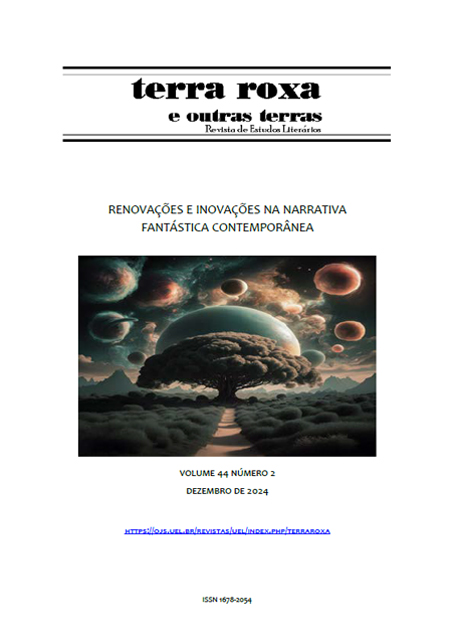Mourning and melancholy in the fantastic (graphic) narrative Raiz (2018), by Dudu Torres: an analysis from the Freudian perspective
DOI:
https://doi.org/10.5433/1678-2054.2024vol44n2p41Keywords:
Freudian psychoanalysis, graphic novel, mourning and melancholy, fantastic narrativeAbstract
The graphic novel Raiz (2018) by Dudu Torres explores the emotional complexity of a boy grieving the death of his grandmother, set against a backdrop of domestic violence that intensifies his melancholic state. Within this context, the protagonist is abruptly confronted by a supernatural event, which expands the narrative by blending reality with elements of the fantastic. To examine these layers of the boy’s behavior through the lens of Freudian psychoanalysis, we apply three key concepts: grief and melancholy, the double, and the death drive. In this analysis, we discuss how the story demonstrates the ability of graphic narratives to convey complex psychological concepts through the integration of images and words. In Raiz, the boy’s drawings help to express his inner emotions, while the depiction of the double visually manifests his guilt and the death drive. This capacity to translate emotional experiences into the realm of the fantastic through graphic imagery is a distinctive feature of this medium, which we aim to highlight in this study.
Downloads
References
D’AGORD, Marta Regina de Leão et al. O duplo como fenômeno psíquico. Revista Latinoamericana de Psicopatologia Fundamental, São Paulo, v. 16, n. 3, p. 475-488, set. 2013. Disponível em: https://doi.org/10.1590/S1415-47142013000300012. DOI: https://doi.org/10.1590/S1415-47142013000300012
EDLER, Sandra. Luto e melancolia: à sombra do espetáculo. Rio de Janeiro: Civilização Brasileira, 2012.
FERNÁNDEZ, Gato. O golpe da barata: tem fantasmas em casa. Trad. Jana Bianchi. São Paulo: Comix Zone, 2021.
FREUD, Sigmund. Luto e melancolia. Trad. Marilene Carone. São Paulo: Cosac Naify, 2013.
FREUD, Sigmund. O infamiliar [Das Unheimliche]; seguido de O Homem da Areia. Trad. Ernani Chaves, Pedro Heliodoro Tavares & Romero Freitas. Belo Horizonte: Autêntica Editora, 2019.
HOFFMANN, E. T. A. O homem de areia. Trad. Ary Quintela. Rio de Janeiro: Rocco Digital, 2012.
MILLER, Frank. Batman: O cavaleiro das trevas. São Paulo: Panini Comics, 2011.
PEREIRA, Mario Eduardo Costa. Projeto de uma (psico)patologia do sujeito (I): Redefinição do conceito de psicopatologia à luz da questão do sujeito. Revista Latinoamericana de Psicopatologia Fundamental, São Paulo, v. 22, n. 4, p. 828-858, dez. 2019. Disponível em: https://doi.org/10.1590/1415-4714.2019v22n4p828.10. DOI: https://doi.org/10.1590/1415-4714.2019v22n4p828.10
RANK, Otto. O duplo: Um ensaio psicanalítico. Trad. Erica Sofia Luisa Foerthmann Schultz et al. Porto Alegre: Dublinense, 2013.
SACCO, Joe. Palestina: uma nação ocupada. São Paulo: Conrad, 2023.
SANTAELLA, Lucia. Semiótica aplicada. 2. ed. São Paulo: Cengage Learning, 2018.
SOUZA, Audrey Setton Lopes de. O desenho como instrumento diagnóstico: reflexões a partir da psicanálise. Boletim de Psicologia, São Paulo, v. 61, n. 135, p. 207-215, 2011. Disponível em: https://pepsic.bvsalud.org/pdf/bolpsi/v61n135/v61n135a07.pdf.
SPIEGELMAN, Art. Maus: a história de um sobrevivente. Trad. Antônio de Macedo Soares. São Paulo: Companhia das Letras, 2009.
TORRES, Dudu. Raiz. São Paulo: edição do autor, 2018.
Downloads
Published
How to Cite
Issue
Section
License
Copyright (c) 2024 Jaimson Machado Garcia, Ana Cláudia Munari Domingos

This work is licensed under a Creative Commons Attribution 4.0 International License.
Authors who publish in this journal agree to the following terms:
a) The authors retain the copyright and grant the journal the right of first publication, the work being simultaneously licensed under the Creative Commons Attribution-NonCommercial 4.0 International License, allowing the sharing of the work with acknowledgment of the authorship of the work and initial publication in this journal.
b) Authors are authorized to assume additional contracts separately, for non-exclusive distribution of the version of the work published in this journal (eg, publish in an institutional repository or as a book chapter), with acknowledgment of authorship and initial publication in this journal.
c) Authors are allowed and encouraged to publish and distribute their work online (e.g. in institutional repositories or on their personal page) after the editorial process, as this can generate productive changes as well as increase impact and citation of the published work (See The Effect of Open Access).
d) The authors of the approved works authorize the journal to, after publication, transfer their content for reproduction in content indexers, virtual libraries and the like.
e) The authors assume that the texts submitted for publication are of their original creation, taking full responsibility for their content in case of any objection by third parties.



















